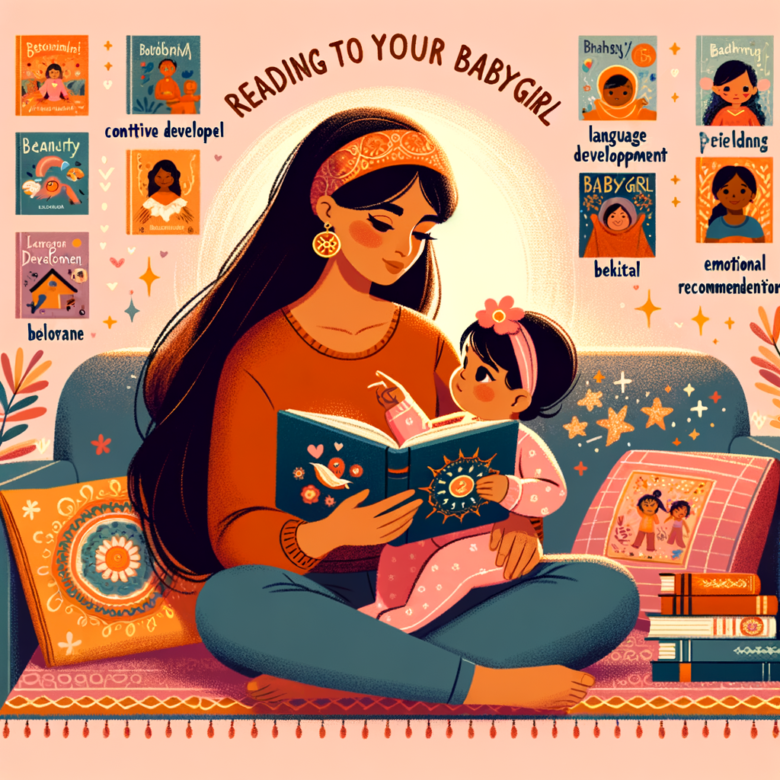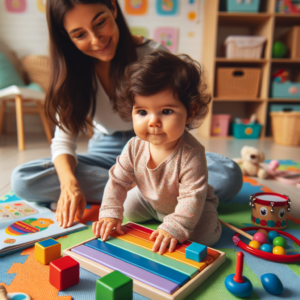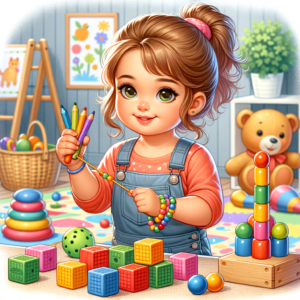Reading to your babygirl is one of the most beneficial activities you can engage in for her cognitive, language, and social-emotional development. It’s never too early to start this wonderful habit. This comprehensive guide will explore the benefits of reading to your babygirl, provide tips for making reading time enjoyable, and offer age-appropriate book recommendations.
Benefits of Reading to Your Babygirl
- Language Development
- Exposes her to a rich vocabulary
- Helps her understand language structure
- Cognitive Skills
- Stimulates imagination and creativity
- Enhances memory and concentration
- Bonding
- Creates special one-on-one time
- Builds positive associations with reading
- Pre-Literacy Skills
- Introduces concepts of print (left to right, top to bottom)
- Develops phonological awareness
- Emotional Development
- Helps her understand and process emotions
- Introduces new experiences through stories
- Cultural Awareness
- Exposes her to diverse characters and situations
- Helps build empathy and understanding
Tips for Reading to Your Babygirl
- Start Early
- Begin reading to your babygirl from birth
- Make it a Routine
- Set aside dedicated reading time each day
- Be Animated
- Use different voices for characters
- Incorporate gestures and facial expressions
- Engage Interactively
- Ask questions about the story and pictures
- Encourage her to touch and explore the book
- Follow Her Lead
- Let her choose books and set the pace
- It’s okay if she doesn’t sit still for the whole story
- Read Favorites Repeatedly
- Repetition helps with language learning
- Familiarity builds confidence
- Point to Words and Pictures
- This helps her connect words with their meanings
- Make Books Accessible
- Keep books within her reach for exploration
Age-Appropriate Book Recommendations
0-6 Months
Focus on high-contrast images and simple, rhythmic text:
- “Black & White” by Tana Hoban
- “Goodnight Moon” by Margaret Wise Brown
- “The Very Hungry Caterpillar” by Eric Carle
- “Moo, Baa, La La La!” by Sandra Boynton
6-12 Months
Introduce books with simple stories and interactive elements:
| 1. “Pat the Bunny” by Dorothy Kunhardt |
|---|
- “Where Is Baby’s Belly Button?” by Karen Katz
- “Dear Zoo” by Rod Campbell
- “Brown Bear, Brown Bear, What Do You See?” by Bill Martin Jr.
12-18 Months
Choose books with simple plots and familiar objects:
| 1. “The Gruffalo” by Julia Donaldson |
|---|
- “Giraffes Can’t Dance” by Giles Andreae
- “Guess How Much I Love You” by Sam McBratney
- “The Going to Bed Book” by Sandra Boynton
18-24 Months
Look for books with slightly longer stories and more complex vocabulary:
| 1. “The Tale of Peter Rabbit” by Beatrix Potter |
|---|
- “Corduroy” by Don Freeman
- “The Snowy Day” by Ezra Jack Keats
- “We’re Going on a Bear Hunt” by Michael Rosen
Types of Books to Include in Your Babygirl’s Library
- Board Books: Durable for little hands
- Texture Books: Encourage sensory exploration
- Lift-the-Flap Books: Promote interactive reading
- Picture Books: Introduce more complex stories and art
- Nursery Rhyme Collections: Support language development
- Concept Books: Teach colors, numbers, shapes, etc.
- Diverse Books: Represent various cultures and experiences
Creating a Reading-Friendly Environment
- Comfortable Reading Nook
- Set up a cozy space with soft cushions or a rocking chair
- Book Storage
- Use low shelves or baskets for easy access
- Good Lighting
- Ensure proper lighting for reading
- Minimize Distractions
- Choose a quiet area for reading time
Frequently Asked Questions
Q: How long should reading sessions be? A: For young babies, start with just a few minutes and gradually increase as your babygirl’s attention span grows.
Q: What if my babygirl isn’t interested in books? A: Keep trying! Vary your approach, choose different types of books, and make reading time fun and interactive.
Q: Is it okay to read the same book over and over? A: Absolutely! Repetition is beneficial for language development and builds confidence.
Q: Can I read adult books to my babygirl? A: While age-appropriate books are best, reading anything aloud can be beneficial. Your babygirl will enjoy hearing your voice and picking up language patterns.
Conclusion
Reading to your babygirl is a simple yet powerful way to support her development and create lasting bonds. It’s an investment in her future that pays dividends in cognitive skills, language abilities, and a lifelong love of learning.
Remember, it’s not just about the words on the page—it’s about the warm, loving interaction between you and your babygirl. The time you spend reading together is precious, creating memories and associations that will last a lifetime.
As you embark on this reading journey with your babygirl, be patient and persistent. Some days she may be more interested than others, and that’s okay. The key is to make reading a regular, enjoyable part of your routine.
Celebrate each moment of engagement, whether it’s her reaching for a page, pointing at a picture, or snuggling close as you read. You’re not just reading stories—you’re opening up a world of imagination, learning, and love that will enrich your babygirl’s life for years to come. Happy reading!



